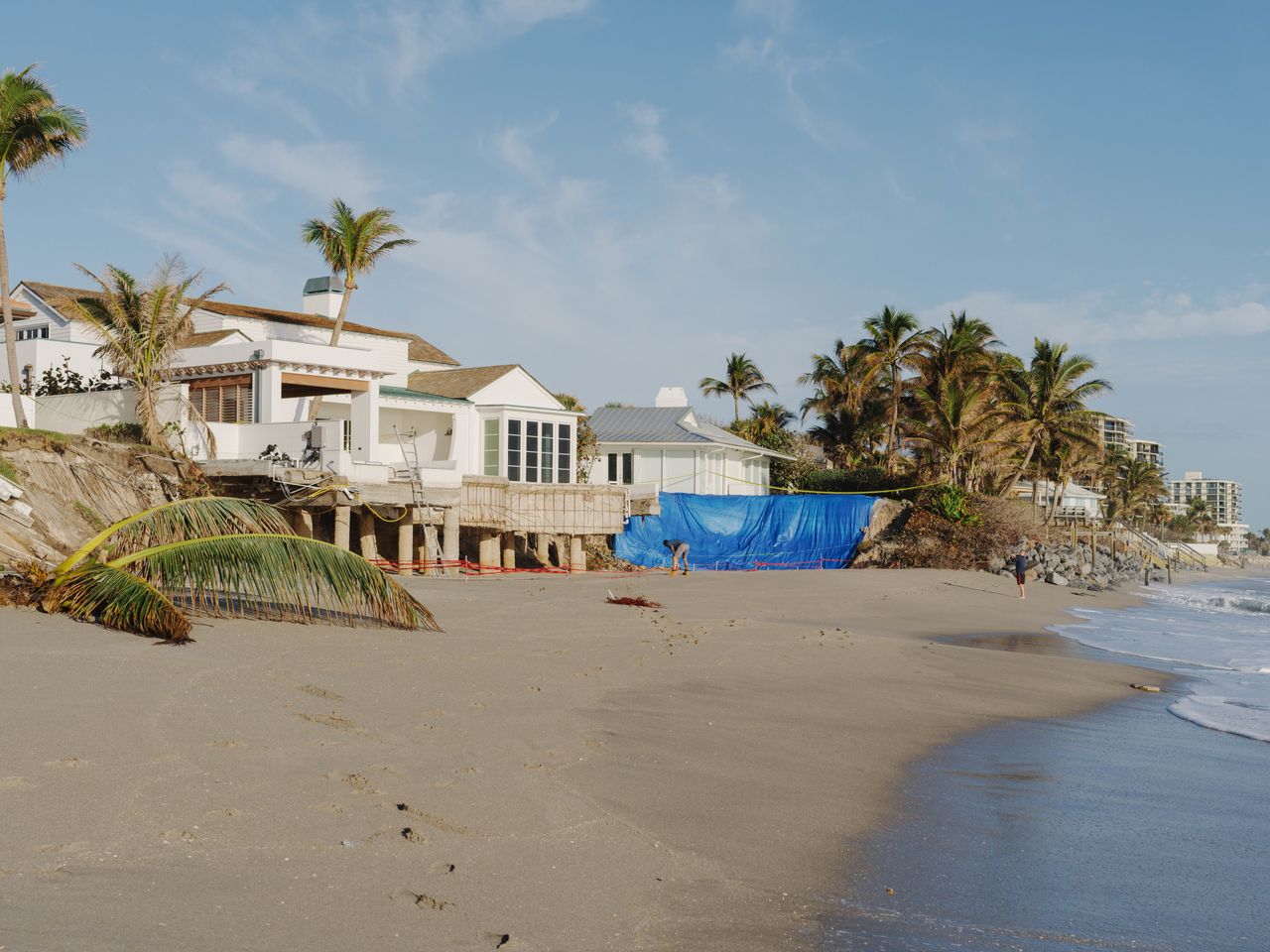They Were About to Move In When the Ocean Almost Washed Away Their New Home
Gail and Ron Fink’s property in Jupiter Inlet Colony sustained major damage during an unusually windy day. ‘The whole backyard is shot. All the landscaping is gone.’
Gail and Ron Fink weren’t home the day the ocean swallowed their backyard.
The Florida couple, who are in their 70s, were a few miles away on Feb. 6—an unusually blustery day in the Sunshine State—as waves pounded their beachfront property in Jupiter Inlet Colony, sweeping sand, dirt and trees out to sea. When it was all over, the Finks’ newly-built, roughly 10,000-square-foot home was intact; so too was their free-form swimming pool, improbably balanced on exposed concrete-and-steel pilings.
“That’s what saved the whole thing,” said Ron, founder of an air- and-water purification company. “The pilings are holding up the house and pool.”
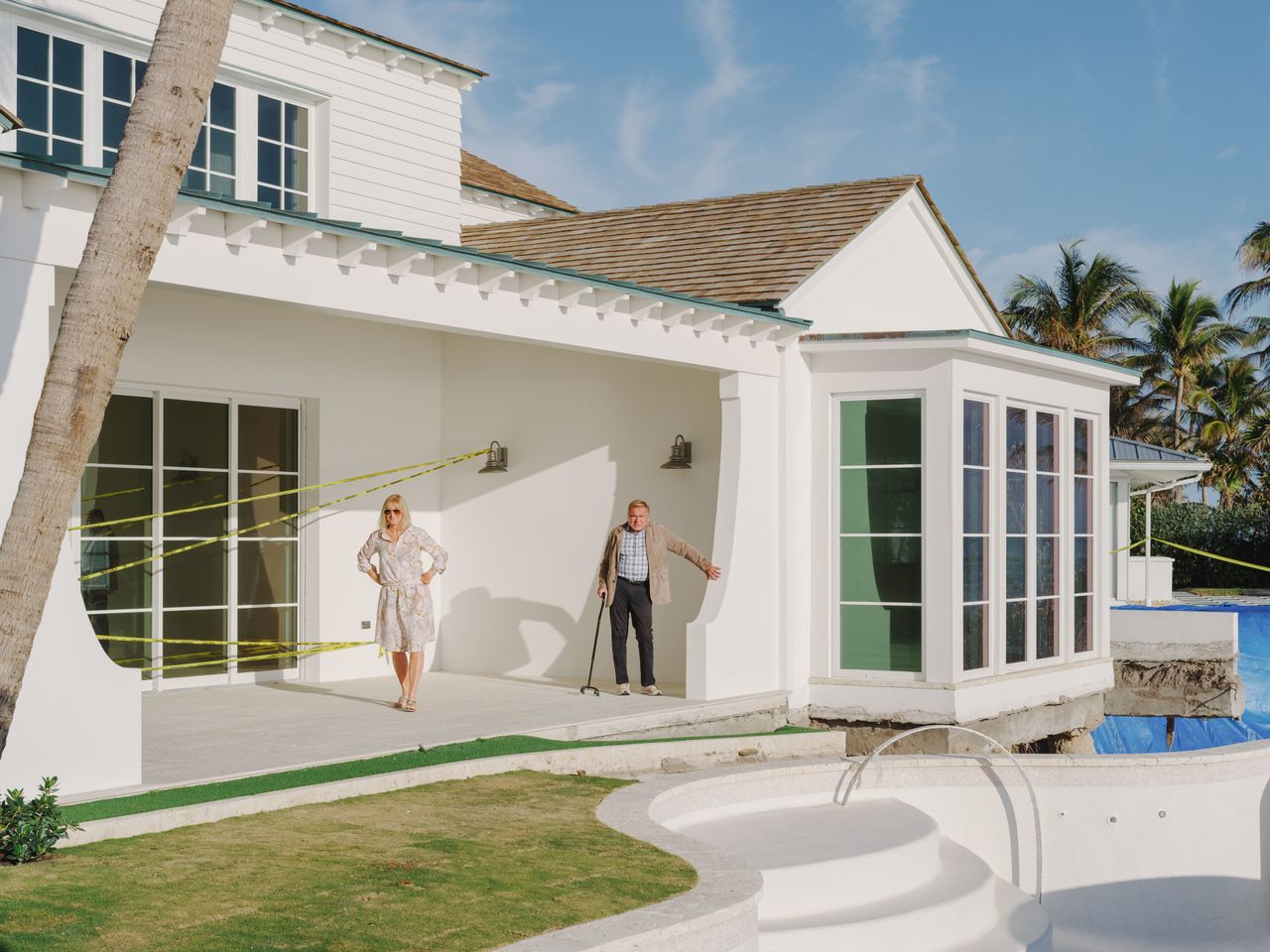
Drone footage and pictures from local photographers and the Finks’ builder show the severity of the destruction, which left their pool suspended in the air, with pipes protruding from the earth. Town officials said erosion claimed 7 to 10 feet of sand and created steep drop-offs in front of about half-dozen homes, including one belonging to Kid Rock , the rapper-turned-country rocker, who paid $3.2 million for the property in 2012. Conair heiress Babe Rizzuto also sustained damage to her property down the street, which she bought for $6.3 million in 2015 and currently has listed for $22.5 million, according to Zillow. Neither responded to requests for comment.
But the Finks house, located just past the end of a granite revetment wall—a kind of sea wall—bore the brunt of the heavy wind and waves.
“The whole backyard is shot. All the landscaping is gone,” said Ron. Also gone are fully matured Palm trees and an ipe-wood deck. “It’s out floating in the ocean someplace.” Ron is self-insured and the repair work will be quite expensive. undefined
A New Jersey native, Ron is an engineer by training who worked at nuclear-testing sites in California and Nevada before moving to Florida in the 1980s. He is the founder of RGF Environmental Group, which makes air- water-and food-purification systems.
For almost 40 years, the Finks—who have three adult children and eight grandchildren—have lived in Admirals Cove, a gated community in Jupiter about 5 miles from their new house. They paid $180,000 for the Admirals Cove lot in 1987 and built a roughly 6,000-square-foot house, Ron said. The Finks also own homes in the Cayman Islands and Bahamas.
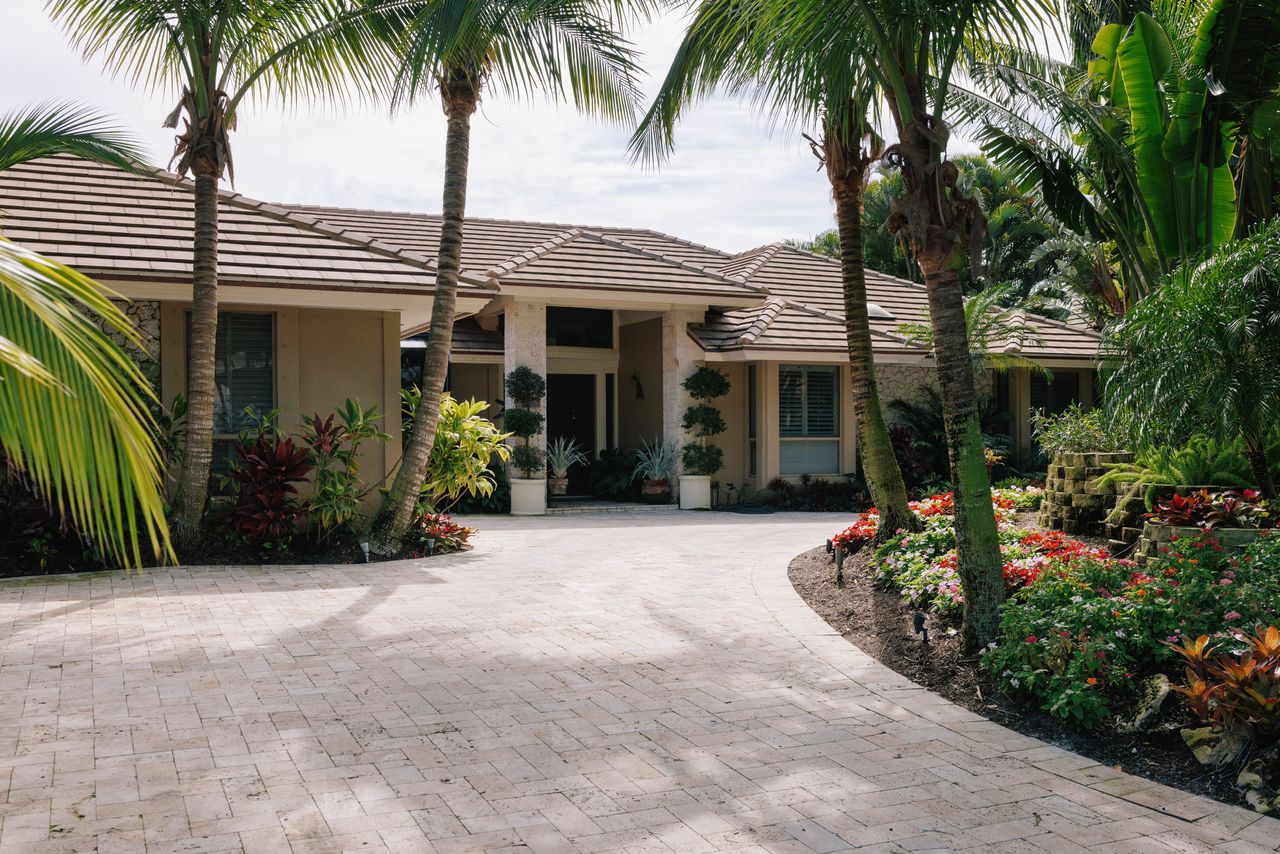
Ron said they began looking for property in Jupiter Inlet Cove years ago. “It’s a neat place, just a closed little colony right on the ocean, low key and quiet,” he said.
About 20 miles north of Palm Beach, Jupiter Inlet Colony is at the southern tip of Jupiter Island. The town, founded around 1959, has approximately 240 homes and is surrounded on three sides by water—the Atlantic Ocean, Jupiter Inlet and the Intracoastal Waterway. Long a destination for wealthy homeowners, homes in Jupiter Inlet Colony tend to trade for between $2 million and $5 million, although one sold for $18.6 million in January, according to real-estate brokerage Redfin. Last year, a home on the Intracoastal sold for $21.4 million, a record for the town.
In 2020, the Finks paid $4.9 million for a vacant beachfront lot and subsequently built a coastal-style house with a copper-and shake-style roof, covered loggia, pool and outdoor fire pit. “You know, it’s kind of a dream home,” Ron said. “We have built quite a few homes, but this is the end of the line for us, hopefully the last one.”
He said the property originally belonged to the singer Perry Como, one of the town’s first residents. A prior owner demolished Como’s house, and when the Finks bought it, there were concrete-and-steel pilings sticking out of the ground.
Ron Fink said he never removed about 60 pilings, he simply added roughly 30 more. “Now I’m glad I did,” he said. (Pilings are based on the design of a house, so Ron retained some pilings that he didn’t necessarily need.)
John Melhorn of design-build firm Thomas Melhorn, which built the house, said the Finks were a final review away from obtaining a certificate of occupancy when the backyard was destroyed. “They were right there at the goal line,” he said.
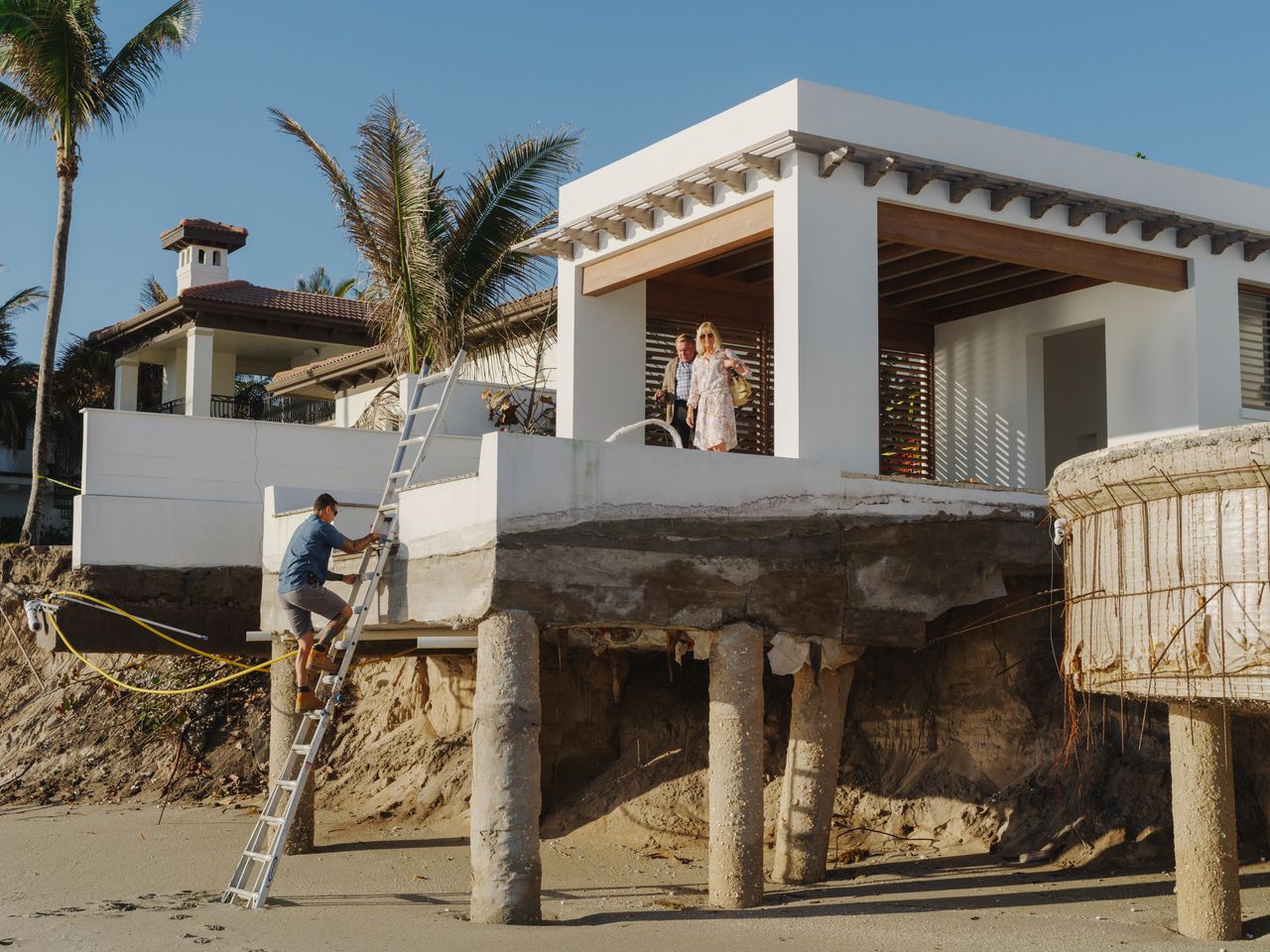
Melhorn said the erosion began in late October amid unusually high winds and ocean swell. During the first week of February, sand beneath a row of sea grapes that stabilized the dunes between the house and ocean began to wash away. By the evening of Feb. 6, the plantings disappeared. The yard was gone by the next morning.
Melhorn said a pre-existing, low wall between the ocean and house—described as a cinder-block retaining wall on land surveys—also washed away, as did a walkway and steps to the beach. But he said the 2-foot-high wall was less of a retaining wall and more like a curb between the street and sidewalk. In this case, a prior owner used it to hold sea grapes back from encroaching on the property. The Finks replaced the wall with decorative stone, now lost to the ocean. An outdoor fire pit is still there, cantilevered over the ocean. “We tried to pull as many things out as we saw the erosion coming, but we lost a lot,” Melhorn said.
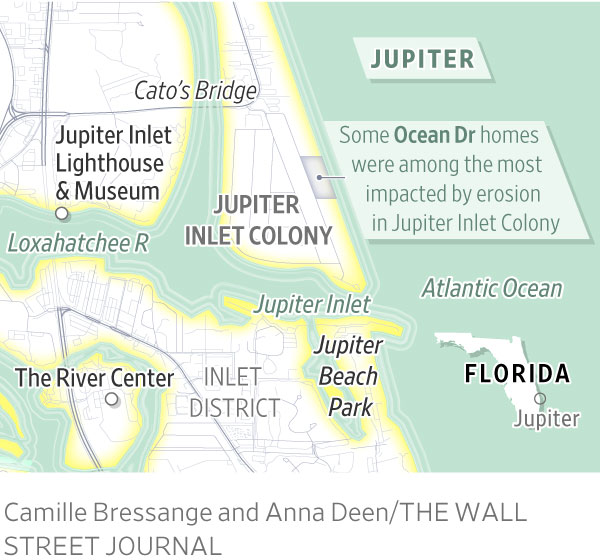
In Florida, erosion is increasing because of more frequent, more severe storms and sea-level rise, said Cheryl Hapke, a research professor at the University of South Florida and the chair of the Florida Coastal Mapping Program. But she said it isn’t just hurricane-level storms that cause major damage. “One thing I have found about barrier islands [like Jupiter Inlet Colony] is that sometimes a series of smaller events can have as big an impact as a major hurricane,” she said. “But people get caught off guard. It’s something they don’t think of.”
In Jupiter Inlet Colony, longtime residents said this month’s erosion is the worst the area has seen in years, possibly ever.
Mayor Ed Hocevar, who has lived there for 17 years, said it has been a particularly cool and challenging winter with an abnormal number of Nor’easters. On Feb. 6, local news channels warned of high winds, with gusts between 40 and 50 miles an hour. (There were also reports of an earthquake off the coast that week, causing high waves.)
Since the 1980s, Jupiter Inlet Colony has had a granite rock revetment wall that extends from the northern end of the community past 11 oceanfront homes. “But we’ve got 28 homes along the beachfront, so it isn’t complete,” Hocevar said. “Where the wall ended is where the significant damage occurred.” Hocevar said he doesn’t know why the wall wasn’t completed, although local lore is that homeowners building the wall ran out of money.
Last week, the town hired a local mining company to bring in 7,000 tons of sand to replace what washed away. Hocevar said it would cost about $500,000, which will come out of the town’s reserve fund. Long term, he said, extending the revetment wall isn’t a strong possibility.
Hapke, the coastal geology expert, said that in recent decades, sea walls and hardened structures have fallen out of favor as scientists discovered they are detrimental to the environment around them. “Storm water wants to flow, so it will redirect water to the area without a sea wall,” she said, adding that the most ideal long-term solution is to move homes away from the coastline.
Hocevar, 67, who has been mayor of Jupiter Inlet Colony for about a month, said the town is working closely with the Department of Environmental Protection on its response. He said the DEP’s recommendation, should erosion like this occur again, is to bring in more sand. Hocevar emphasised that the community is rallying together. “Think about it as a fortress and your wall has been breached,” he said. “You want to protect your neighbourhood and that’s what we’re trying to do here.”
Holly Meyer Lucas of Compass, who represented the seller when the Finks purchased their property, said Jupiter Inlet Colony is a “special little enclave” where sales exploded during Covid. “Listings sell after a day or sell off-market,” she said.
Lucas said the consensus among local real-estate agents is that property values will hold, despite the erosion. “I think this is a really rare, weird, fluky event,” she said. “I’ve sold everywhere up and down the coast and I’ve never heard of anything like this.”
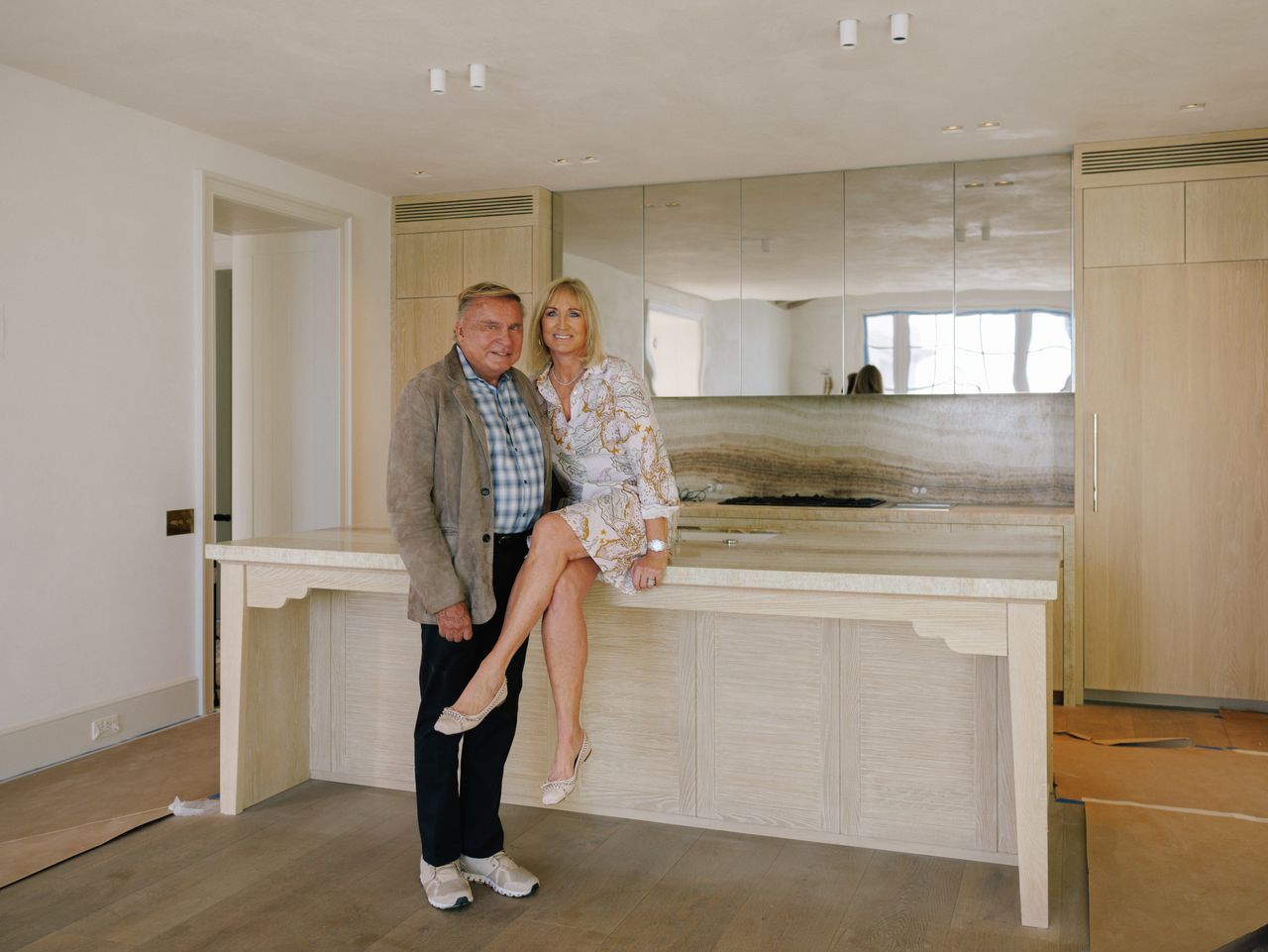
Babe Rizzuto, whose house is two doors down from the Finks, listed her house for $24.5 million in December 2023 and cut the price to $22.5 million on Feb. 6, according to Zillow.
“She’s going to continue to sell,” said Milla Russo of Illustrated Properties, who is marketing the property with her husband, Andrew Russo. “Even though the timing isn’t great, it is what it is.”
Russo said there has been erosion in the past, and during hurricanes residents of Jupiter Inlet Colony are the first in the area to evacuate. But in general, people are not preoccupied with the weather. “Maybe because we live here, when the hurricanes come, we all have hurricane parties. We go to people’s homes and we barbecue and grill. Of course we’re careful and we lock up and all that, but weather is weather,” she said. “We’ve never been terribly scared.”
(The Russos were also involved in selling the Fink property. However, in 2020 the closing agent on the deal, Florida-based Eavenson, Fraser & Lunsford, PLLC, sued Milla Russo and Illustrated Properties as part of a commission dispute. The seller, Michael Cantor’s Range Road Developers, was named as a defendant and cross-plaintiff in the suit, in which a judge ruled in favor of Eavenson, court records show. Milla Russo declined to comment on the suit. Eavenson declined to comment beyond the judge’s findings and Cantor did not respond to requests for comment.)
Ron was also matter-of-fact about the state of beachfront living. Bring a life jacket, he jokingly told a photographer who inquired last week about taking his picture.
However, the Finks are facing weeks of costly repairs. Although the town is bringing in sand to replace the decimated beachfront, the couple is self-insured and will be on the hook for the cost of rebuilding. Several major home insurers have pulled out of Florida, and Ron said insurance on the house would have cost $100,000 a year. Now, he estimated they could face about $1 million worth of repair work. “We gotta eat it,” he said.
The couple, who was supposed to move into the house this month, has put those plans on hold—for now. An engineer recently inspected the property and deemed the house safe, Ron said. “We’re doing wallpaper today,” he said. “We can put it back together again.” The patio and pool area, meanwhile, are roped off while the area underneath is backfilled with sand.
Ron said being near the ocean makes it worthwhile. “I just love the ocean, we both do. It’s important to us,” he said. “It isn’t easy to look at, but I’ve been through a lot worse.”
 Copyright 2020, Dow Jones & Company, Inc. All Rights Reserved Worldwide. LEARN MORE
Copyright 2020, Dow Jones & Company, Inc. All Rights Reserved Worldwide. LEARN MORE
This stylish family home combines a classic palette and finishes with a flexible floorplan
Just 55 minutes from Sydney, make this your creative getaway located in the majestic Hawkesbury region.
Ahead of the Games, a breakdown of the city’s most desirable places to live
PARIS —Paris has long been a byword for luxurious living. The traditional components of the upscale home, from parquet floors to elaborate moldings, have their origins here. Yet settling down in just the right address in this low-rise, high-density city may be the greatest luxury of all.
Tradition reigns supreme in Paris real estate, where certain conditions seem set in stone—the western half of the city, on either side of the Seine, has long been more expensive than the east. But in the fashion world’s capital, parts of the housing market are also subject to shifting fads. In the trendy, hilly northeast, a roving cool factor can send prices in this year’s hip neighborhood rising, while last year’s might seem like a sudden bargain.
This week, with the opening of the Olympic Games and the eyes of the world turned toward Paris, The Wall Street Journal looks at the most expensive and desirable areas in the City of Light.
The Most Expensive Arrondissement: the 6th
Known for historic architecture, elegant apartment houses and bohemian street cred, the 6th Arrondissement is Paris’s answer to Manhattan’s West Village. Like its New York counterpart, the 6th’s starving-artist days are long behind it. But the charm that first wooed notable residents like Gertrude Stein and Jean-Paul Sartre is still largely intact, attracting high-minded tourists and deep-pocketed homeowners who can afford its once-edgy, now serene atmosphere.
Le Breton George V Notaires, a Paris notary with an international clientele, says the 6th consistently holds the title of most expensive arrondissement among Paris’s 20 administrative districts, and 2023 was no exception. Last year, average home prices reached $1,428 a square foot—almost 30% higher than the Paris average of $1,100 a square foot.
According to Meilleurs Agents, the Paris real estate appraisal company, the 6th is also home to three of the city’s five most expensive streets. Rue de Furstemberg, a secluded loop between Boulevard Saint-Germain and the Seine, comes in on top, with average prices of $2,454 a square foot as of March 2024.
For more than two decades, Kyle Branum, a 51-year-old attorney, and Kimberly Branum, a 60-year-old retired CEO, have been regular visitors to Paris, opting for apartment rentals and ultimately an ownership interest in an apartment in the city’s 7th Arrondissement, a sedate Left Bank district known for its discreet atmosphere and plutocratic residents.
“The 7th was the only place we stayed,” says Kimberly, “but we spent most of our time in the 6th.”
In 2022, inspired by the strength of the dollar, the Branums decided to fulfil a longstanding dream of buying in Paris. Working with Paris Property Group, they opted for a 1,465-square-foot, three-bedroom in a building dating to the 17th century on a side street in the 6th Arrondissement. They paid $2.7 million for the unit and then spent just over $1 million on the renovation, working with Franco-American visual artist Monte Laster, who also does interiors.
The couple, who live in Santa Barbara, Calif., plan to spend about three months a year in Paris, hosting children and grandchildren, and cooking after forays to local food markets. Their new kitchen, which includes a French stove from luxury appliance brand Lacanche, is Kimberly’s favourite room, she says.
Another American, investor Ashley Maddox, 49, is also considering relocating.
In 2012, the longtime Paris resident bought a dingy, overstuffed 1,765-square-foot apartment in the 6th and started from scratch. She paid $2.5 million and undertook a gut renovation and building improvements for about $800,000. A centrepiece of the home now is the one-time salon, which was turned into an open-plan kitchen and dining area where Maddox and her three children tend to hang out, American-style. Just outside her door are some of the city’s best-known bakeries and cheesemongers, and she is a short walk from the Jardin du Luxembourg, the Left Bank’s premier green space.
“A lot of the majesty of the city is accessible from here,” she says. “It’s so central, it’s bananas.” Now that two of her children are going away to school, she has listed the four-bedroom apartment with Varenne for $5 million.
The Most Expensive Neighbourhoods: Notre-Dame and Invalides
Garrow Kedigian is moving up in the world of Parisian real estate by heading south of the Seine.
During the pandemic, the Canada-born, New York-based interior designer reassessed his life, he says, and decided “I’m not going to wait any longer to have a pied-à-terre in Paris.”
He originally selected a 1,130-square-foot one-bedroom in the trendy 9th Arrondissement, an up-and-coming Right Bank district just below Montmartre. But he soon realised it was too small for his extended stays, not to mention hosting guests from out of town.
After paying about $1.6 million in 2022 and then investing about $55,000 in new decor, he put the unit up for sale in early 2024 and went house-shopping a second time. He ended up in the Invalides quarter of the 7th Arrondissement in the shadow of one Paris’s signature monuments, the golden-domed Hôtel des Invalides, which dates to the 17th century and is fronted by a grand esplanade.
His new neighbourhood vies for Paris’s most expensive with the Notre-Dame quarter in the 4th Arrondissement, centred on a few islands in the Seine behind its namesake cathedral. According to Le Breton, home prices in the Notre-Dame neighbourhood were $1,818 a square foot in 2023, followed by $1,568 a square foot in Invalides.
After breaking even on his Right Bank one-bedroom, Kedigian paid $2.4 million for his new 1,450-square-foot two-bedroom in a late 19th-century building. It has southern exposures, rounded living-room windows and “gorgeous floors,” he says. Kedigian, who bought the new flat through Junot Fine Properties/Knight Frank, plans to spend up to $435,000 on a renovation that will involve restoring the original 12-foot ceiling height in many of the rooms, as well as rescuing the ceilings’ elaborate stucco detailing. He expects to finish in 2025.
Over in the Notre-Dame neighbourhood, Belles demeures de France/Christie’s recently sold a 2,370-square-foot, four-bedroom home for close to the asking price of about $8.6 million, or about $3,630 a square foot. Listing agent Marie-Hélène Lundgreen says this places the unit near the very top of Paris luxury real estate, where prime homes typically sell between $2,530 and $4,040 a square foot.
The Most Expensive Suburb: Neuilly-sur-Seine
The Boulevard Périphérique, the 22-mile ring road that surrounds Paris and its 20 arrondissements, was once a line in the sand for Parisians, who regarded the French capital’s numerous suburbs as something to drive through on their way to and from vacation. The past few decades have seen waves of gentrification beyond the city’s borders, upgrading humble or industrial districts to the north and east into prime residential areas. And it has turned Neuilly-sur-Seine, just northwest of the city, into a luxury compound of first resort.
In 2023, Neuilly’s average home price of $1,092 a square foot made the leafy, stately community Paris’s most expensive suburb.
Longtime residents, Alain and Michèle Bigio, decided this year is the right time to list their 7,730-square-foot, four-bedroom townhouse on a gated Neuilly street.
The couple, now in their mid 70s, completed the home in 1990, two years after they purchased a small parcel of garden from the owners next door for an undisclosed amount. Having relocated from a white-marble château outside Paris, the couple echoed their previous home by using white- and cream-coloured stone in the new four-story build. The Bigios, who will relocate just back over the border in the 16th Arrondissement, have listed the property with Emile Garcin Propriétés for $14.7 million.
The couple raised two adult children here and undertook upgrades in their empty-nester years—most recently, an indoor pool in the basement and a new elevator.
The cool, pale interiors give way to dark and sardonic images in the former staff’s quarters in the basement where Alain works on his hobby—surreal and satirical paintings, whose risqué content means that his wife prefers they stay downstairs. “I’m not a painter,” he says. “But I paint.”
The Trendiest Arrondissement: the 9th
French interior designer Julie Hamon is theatre royalty. Her grandfather was playwright Jean Anouilh, a giant of 20th-century French literature, and her sister is actress Gwendoline Hamon. The 52-year-old, who divides her time between Paris and the U.K., still remembers when the city’s 9th Arrondissement, where she and her husband bought their 1,885-square-foot duplex in 2017, was a place to have fun rather than put down roots. Now, the 9th is the place to do both.
The 9th, a largely 19th-century district, is Paris at its most urban. But what it lacks in parks and other green spaces, it makes up with nightlife and a bustling street life. Among Paris’s gentrifying districts, which have been transformed since 2000 from near-slums to the brink of luxury, the 9th has emerged as the clear winner. According to Le Breton, average 2023 home prices here were $1,062 a square foot, while its nearest competitors for the cool crown, the 10th and the 11th, have yet to break $1,011 a square foot.
A co-principal in the Bobo Design Studio, Hamon—whose gut renovation includes a dramatic skylight, a home cinema and air conditioning—still seems surprised at how far her arrondissement has come. “The 9th used to be well known for all the theatres, nightclubs and strip clubs,” she says. “But it was never a place where you wanted to live—now it’s the place to be.”
With their youngest child about to go to college, she and her husband, 52-year-old entrepreneur Guillaume Clignet, decided to list their Paris home for $3.45 million and live in London full-time. Propriétés Parisiennes/Sotheby’s is handling the listing, which has just gone into contract after about six months on the market.
The 9th’s music venues were a draw for 44-year-old American musician and piano dealer, Ronen Segev, who divides his time between Miami and a 1,725-square-foot, two-bedroom in the lower reaches of the arrondissement. Aided by Paris Property Group, Segev purchased the apartment at auction during the pandemic, sight unseen, for $1.69 million. He spent $270,000 on a renovation, knocking down a wall to make a larger salon suitable for home concerts.
During the Olympics, Segev is renting out the space for about $22,850 a week to attendees of the Games. Otherwise, he prefers longer-term sublets to visiting musicians for $32,700 a month.
Most Exclusive Address: Avenue Junot
Hidden in the hilly expanses of the 18th Arrondissement lies a legendary street that, for those in the know, is the city’s most exclusive address. Avenue Junot, a bucolic tree-lined lane, is a fairy-tale version of the city, separate from the gritty bustle that surrounds it.
Homes here rarely come up for sale, and, when they do, they tend to be off-market, or sold before they can be listed. Martine Kuperfis—whose Paris-based Junot Group real-estate company is named for the street—says the most expensive units here are penthouses with views over the whole of the city.
In 2021, her agency sold a 3,230-square-foot triplex apartment, with a 1,400-square-foot terrace, for $8.5 million. At about $2,630 a square foot, that is three times the current average price in the whole of the 18th.
Among its current Junot listings is a 1930s 1,220-square-foot townhouse on the avenue’s cobblestone extension, with an asking price of $2.8 million.
This stylish family home combines a classic palette and finishes with a flexible floorplan
Just 55 minutes from Sydney, make this your creative getaway located in the majestic Hawkesbury region.









